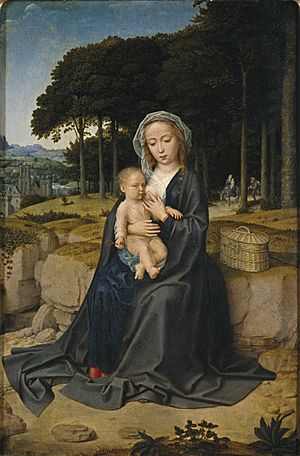Rest on the Flight into Egypt (David, Madrid) facts for kids
Quick facts for kids Rest on the Flight into Egypt |
|
|---|---|
 |
|
| Artist | Gerard David |
| Year | c. 1515 |
| Medium | Oil on panel |
| Movement | Gothic |
| Dimensions | 60 cm × 39 cm (24 in × 15 in) |
| Location | Museo del Prado, Madrid |
The Rest on the Flight into Egypt is a famous oil painting. It was created around 1515 by the Flemish artist Gerard David. Today, you can see it at the Prado Museum in Madrid, Spain.
This painting shows a quiet moment from a Bible story. It's about Mary, Joseph, and baby Jesus. They are resting during their journey to Egypt. Gerard David painted this story many times. He made similar versions that are now in New York, Washington, and Antwerp.
Contents
What is the Flight into Egypt?
The story of the Flight into Egypt comes from the Gospel of Matthew in the Bible. It tells how Joseph was warned in a dream. An angel told him to take Mary and Jesus to Egypt. This was to escape King Herod, who wanted to harm baby Jesus.
The Bible does not mention them stopping to rest. But other old stories, called apocryphal accounts, do. These stories describe Mary, Joseph, and Jesus taking a break during their long journey. This "rest" became a very popular topic for painters.
What does the painting show?
Gerard David often focused on Mary in his paintings of this story. In this version, Mary is sitting down. She is breastfeeding the Christ Child. They are placed in front of a deep, green forest.
In the background, you can often see more of their journey. Sometimes it shows them traveling. Other times, it shows another part of their rest. David painted many versions of this scene. They are often very similar, with only small changes.
Looking closely at the details
This painting shows Mary and Jesus in a traditional pose. Mary is shown as Virgo Lactans, which means "Nursing Virgin." In the forest on the left, you can see the Holy Family's journey to Egypt.
On the right side, behind the trees, there is a city. It sits by a river, with hills stretching far away. The painting shows many small details. This was a common style in Flemish art. You can see tiny plants in the front. There is also a food basket. The leaves on the beech and chestnut trees are painted with great care.
The artist used light and shadow to shape Mary's figure. This technique is called chiaroscuro. The colors, especially the blues and greens, change smoothly. This helps to make the landscape look deep and real.
Where did the painting come from?
The painting came to the Prado Museum in 1915. It had been kept in a convent in Navarre, Spain. At first, people thought it was painted by another artist, Hieronymus Bosch. But later, experts realized it was a work by Gerard David.
See also
 In Spanish: Descanso en la huida a Egipto (Gerard David) para niños
In Spanish: Descanso en la huida a Egipto (Gerard David) para niños

